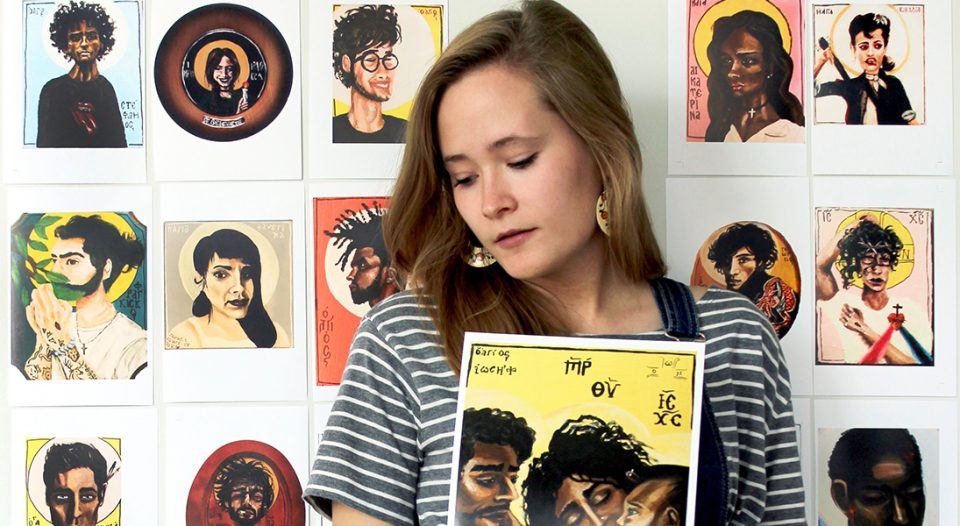Growing up Protestant, I didn’t think much about saints. I saw depictions of them, mostly in The Beginner’s Bible, but they looked like cartoons. I didn’t wonder about the other ways they might not be realistic.
When I came across Gracie Morbitzer’s website The Modern Saints a few years ago, I couldn’t stop looking at her art. It was near Christmastime, and suddenly I was face to face with the holy family as I’d never seen them before. They were a couple, laughing with their baby, all of them with rich brown complexions. They looked like real people, far from the stylized pictures I’d seen. Her art took my breath away. Suddenly these people whose stories I’d been reciting since I was tiny—playing Mary in a nativity play—slipped into sharper focus.
Morbitzer said she started her “Modern Saints” project with the goal of reimagining biblical figures as modern, everyday people, to “show us that we can all be saints, just like them.”
She is prolific, so there was much more of her work to discover as I dove into The Modern Saints. I find myself locking eyes with Mary Magdalene, a smile around her closed lips. She has voluminous dark hair and a red headscarf. When I picture Mary Magdalene—one of the first at the tomb, the first to see Jesus resurrected—it’s this depiction I imagine now.
I see Mary and Elizabeth hugging, each holding ultrasound photos, in a piece called “Visitation.” I’m jarred out of complacency by these modern touches, but they can’t help but connect me as a mother to these two women who went before me. It’s one of the pieces I always display at Advent, an invitation to remember and ponder.
Morbitzer reimagines biblical figures as modern, everyday people, to “show us that we can all be saints, just like them.”
Peter has his hair swept back, tattoos on his shoulder. His bright blue eyes look into mine. I’m embarrassed to realize how I’ve pictured biblical scenes in my mind, populated with people who look like me, perhaps wearing bathrobes, as we did when we dressed up like figures from the Bible. How many times have I sermons about Peter, perhaps critiquing his rough-and-tumble ways or how he seems to put his foot in his mouth? Looking at this picture, I see a fisherman. He doesn’t seem overwhelmed by the way his life has been turned upside down, though he must be.
It’s easy to read through The Modern Saints quickly, looking for the names and stories I know the best, though there are many I’m less familiar with. I see a wary-looking Thomas, famously known for his doubt. But Morbitzer has painted him with something that looks like anger, as well as a hint of fear. He looks like someone trying to protect himself from losing still more.
I am wholly unprepared for Gabriel the archangel, shirtless with a jeweled breastplate. He is commanding, royal in appearance. If he were to appear before me, I’d fall to the ground in terror. The angels in my mind’s eye are all blond, wearing puffy white robes and carrying brass instruments. Gabriel is a revelation, terrifying and beautiful, adding an entirely new dimension to the stories I carry with me.
Perhaps my favorite print is of Madonna and the Christ child. Mary is wearing large gold hoops and jeans with ripped knees. Baby Jesus is laughing and touching her nose. Morbitzer takes something intangible and brings it up close, into my world.
The artist has painted another view of Mary, this time alone. She looks haggard and grief-stricken, the crucifixion all over her face. Both these pictures move me. Each holds a place in my mind.
If, like me, you could stand to challenge your mental pictures of biblical characters, spend some time with Morbitzer’s work. Let the artistry speak. Let the images change you. Let them shake up your faith.





